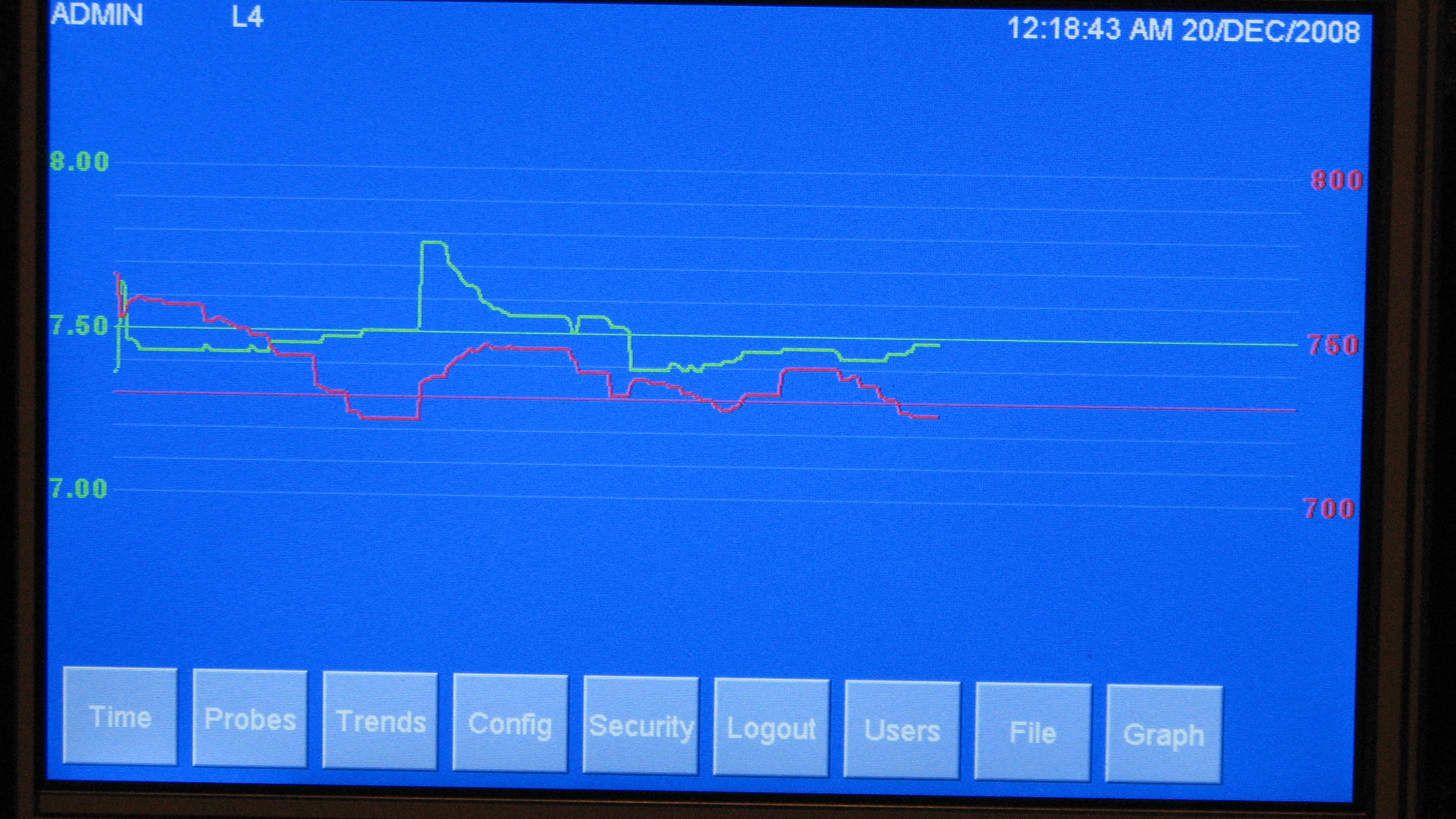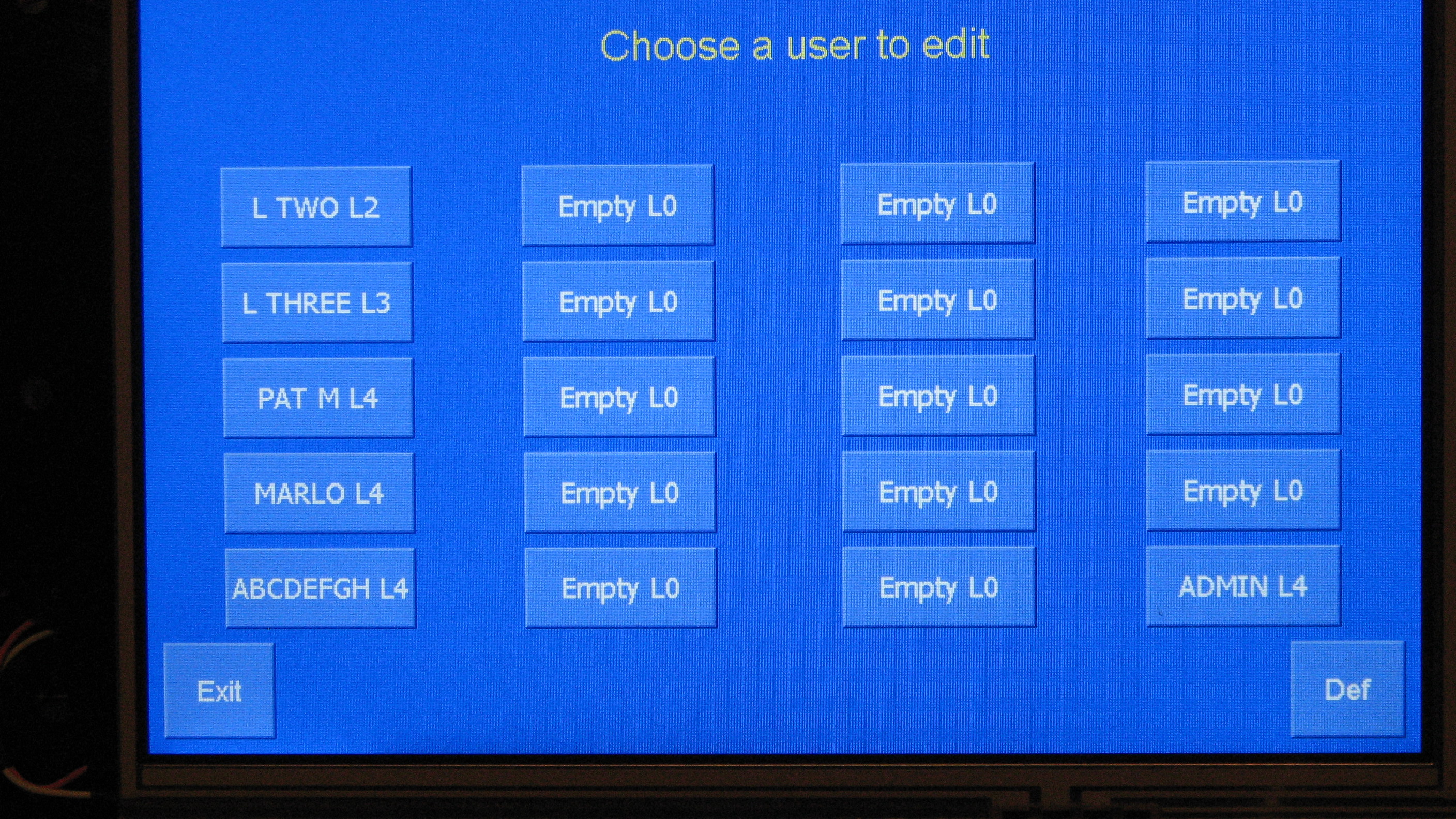(Not) cheap 7
Got one of these a few weeks ago http://cubloc.com/product/02_05.php·and have been having a blast with it. It takes simple serial commands (TTL or RS232 levels) at up to 115200 baud. One of the best things is that it'll run commands from a textfile on SD card. I've made all my menus, buttons, checkboxes etc as textfile commands and then just respond to events that come down the serial pipe. Saves lots of uC and eeprom space! Nice having a gig of SD card to store datalogs and pics on too.
Not cheap though!
Couple of pics attached. Still early, when I get this project done I'll post a video link.
P.S. Wow, the pics look grainy. Dunno why - must be my picture taking skills at 12:30AM after a full day of work and full evening of programming.
Not cheap though!
Couple of pics attached. Still early, when I get this project done I'll post a video link.
P.S. Wow, the pics look grainy. Dunno why - must be my picture taking skills at 12:30AM after a full day of work and full evening of programming.





Comments
Thanks for the heads up on this. I'm using the ezlcd-oo4, and my client would be interested to know that 50 dollars more will upgrede them from 65k color to 260k. Nice! Hows the daylight readability of that module?
▔▔▔▔▔▔▔▔▔▔▔▔▔▔▔▔▔▔▔▔▔▔▔▔
Mosquito: An animal which buzzes in your ear and never stops. He may byte you, he may nibble you, but you will know you were bit.
Technologically challenged individual, Please have pity.
It is expensive because it is an intellegent display that does a lot of the processing itself, simple VGA and NTSC/PAL screens are much cheaper.
Graham
Hacking one of the photodisplay LCDs that are getting cheaper by the moment would be good but its hit or miss whether you can get one that supports the low resolutions that the Prop can put out and even less likely that it also accepts analog RGB. I keep checking to see if someone has finally put one out that plug directly into a PC video card but no luck yet.
·
I am still looking for an lcd screen with touch capabilities, as my part·in the above project is finished.
But if I could remake the same thing for 200 dollars less, christmas would look better next year. The difficult part is know how, and avalibilty of some devices that I can manipulate.
The closest I have come to getting the same thing cheaper·is to buy a cheap lcd (like mentioned in several threads here) and attach an aftermarket touchscreen sensor to it. Then add a SD card (of which my first attempt was a flop.) http://forums.parallax.com/showthread.php?p=696896· If I where able to fund my own research here I would do just that. Proof I can do it isn't readily available, and to get my client to go along with this cheaper approach would definately require it!
Need sleep: Too many typo's
Post Edited (bambino) : 12/31/2007 12:59:08 AM GMT
One of the high quality displays came from a Chinese Playstation add-on monitor, sold at ebay for $30 or so.
Whatever Monitor box you buy, inside will be an RBG monitor which can be controlled by 5 or 6 lines. It must be identified
- what kind of sync is used
- what line frequency is used
Data Sheets are not easy to find, if you are lucky you will get some sheet with kanji glyphs on it...
Andreas even made a documentation (in German of course). Don't be fooled by the terribly design! It can easily be dismantled by unsrewing 62 (or 82?) screews
Note: There is a 320x240 and a 480x240 model. Andreas used the ROM font as example (32 lines high), so there are 7 lines only to be displayed at high quality.
It was 18 € which I boldly converted to $30...
Post Edited (deSilva) : 12/31/2007 3:14:51 AM GMT
Indeed!!!!!!!!!
I don't know how many times I wished I knew the oriental Language.
My latest hope was the juicebox hack, but it is still beyond me.
All these issues should go POOF when the Prop 2 comes out. More than enough memory for higher res with lots more colors and all the speed needed to drive it. Then we should see all sorts of circuits for display through most interface types. Color LCDs are cheap, whats not is getting from your uC to the screen.
What program are you using for your display?
·
So, one either runs the display at a high rate to get the font size within acceptable limits, or one deals with larger than necessary fonts.
Nothing wrong with the ROM fonts, they are cool! Interleaving them with the 4 color mode really packs in a lot of symbols into a small space. But they are just large.
Seems to me, the 8x8 driver, for NTSC TV, could be adapted for VGA. Oldbitcollector has assembled quite a few 8x8 fonts.
▔▔▔▔▔▔▔▔▔▔▔▔▔▔▔▔▔▔▔▔▔▔▔▔
Propeller Wiki: Share the coolness!
·· Some enterprising person out there could buy 10 monitors, get them running and sell it to a dummy like me who doesn't have the knowhow to hack something like this. When parallax sells a 2 inch screen for $90, I have to think there is a market for 5-7 inch screens. I know I need one.
▔▔▔▔▔▔▔▔▔▔▔▔▔▔▔▔▔▔▔▔▔▔▔▔
Mosquito: An animal which buzzes in your ear and never stops. He may byte you, he may nibble you, but you will know you were bit.
Technologically challenged individual, Please have pity.
The font was meant to be displayed on a VGA or full NTSC Monitor and has a decent size there (15 lines). On a QVGA you will have 7 lines only, they are crisp clear but "gargantuan"
I had to hack the TV drivers to display only each even line. This is a crude algorithm as you loose the information of the odd lines... Note this happens in interlaced mode anyhow, but with drastically reduced display quality.
It's the time it takes, Mosquito.
As I posted, a Chinese consumer product - as the mentioned play station monitor - can be bought for $20 (it's a 5,6 inch Sharp LQ6AN101 or something similar). Dismantling it is 1/2 hour, resolder connections and package into a new case will be another half hour. Add another hour for preparation, posting, issues. Add $10 for the new case.
There will be no commercial cost advantage over Car Monitors, but a much improved display quality!
I should see a market for selling the "new case", including assembly instructions. I enclose a picture or two..
And a Happy New Year to all!
Post Edited (deSilva) : 1/1/2008 8:11:47 AM GMT
- 400 pixels/screenline (320 visible)
- 6,0-6,4 MHz pixel clock
- 15,0-16,2kHz horizontal freq.
- 262 screenlines (234 visible)
- HSync: 4,7µs = 28-30 Pixel (dep. on pixel clock)
- VSync: 190µs = 3 lines
- composite sync
·
There will be no more memory used than in two-color mode.
Maybe I misunderstand what you mean by displaying the ROM font in 4-color mode.
The way the font is arranged in the ROM is optimized for two - color mode. Copying them into RAM indeed will soon get you of memory
Post Edited (deSilva) : 1/1/2008 1:36:09 PM GMT
<http://www.display3000.com/>
HTH,
Nick
▔▔▔▔▔▔▔▔▔▔▔▔▔▔▔▔▔▔▔▔▔▔▔▔
Never use force, just go for a bigger hammer!
The DIY Digital-Readout for mills, lathes etc.:
YADRO
----
Edit:
This electronic-assembly.de/deu/pdf/grafik/dogm128.pdf is new however. It is VERY affordable (Reichelt sells them for some weeks now at 13 Euro 132x32 ansd 20 Euro 128x64)
I know their DOGM sereies (2x16 displays) which are very - elegant (But too expensive)
Forget to mention they are monochromious, but need 3.3 V only and can be operated by SPI!
Post Edited (deSilva) : 1/1/2008 9:39:11 PM GMT
The picture frame is set to slide show mode so that it periodically read a·bitmap from an SD card and displays the bitmap.··Four relays are inserted in the SPI interface between the SD card and the picture frame.· A microcontroller periodically·activates the relays to connect the SD card·to the microcontroller instead of to the picture frame.· This lets the microcontroller update the bitmap in the SD card to reflect the current temperature and humidity.· The relays are then deactivated so the SD card is again connected to the picture frame.· The next time the picture frame reads from the card it will get the updated picture.
The article shows the same technique being used to display data on a pocket pc and on a cell phone.
By the way, the same issue has an article about·implementing tile based graphics on a propeller chip.
Edit: Here comes the link to the PDF www.circuitcellar.com/archives/viewable/209-Davaine/Davaine-209.pdf
Post Edited (deSilva) : 1/2/2008 1:20:37 AM GMT
-Phil
Post Edited (Phil Pilgrim (PhiPi)) : 1/1/2008 11:49:12 PM GMT
The first on the Mouser page, $18.07 x1, uses a Samsung driver s6b1713. So first difference is ram size: only 8580 bits here.
Post Edited (Fred Hawkins) : 1/2/2008 1:56:48 AM GMT
The Displaytech unit is very close to the metal, with its 8580 bits of user memory corresponding to one bit per pixel. With it, you can turn pixels on and off. That's it. To make it do anything useful requires programming from the ground up — not to mention some kind of enclosure, a specialized interface, and external circuitry for user feedback.
The AutomaitonDirect displays, OTOH, are complete systems with an RS232 interface and development software that lets you design entire screens and controls that are stored internally in the units' copious memory. This allows the display unit to handle all the display chores internally. This frees your program to deal with just the data that gets displayed or that is passed back from the built-in pushbuttons or touchscreen.
-Phil
There is inbuilt 7x5 and 8x8 fonts, which can be placed at any· screen position (not just limited to character cells)
It is possible to reprogram characters to a custom font.. for 'stylus pointer' arrow etc!!
+ floating character support, (so you can have an arrow, or whatever) to track the touch screen stylus!!!
circa $80 usd each
http://www.multilabs.net/ezDISPLAY_Mini.html
The only thing is, that the command set is not as feature rich as some of the more expensive units, from other companies...
.. meaning, you will have to do 'more work' with the prop to get fancy GUI screens!!
Looks like a winner for what I want to do!!!
What we connect now is no longer a "display" but a "computer" - the protocol is arbitrary, the features as well. This will be the reason for most headache: You will have to adjust your program to a specific variant of a specific vendor.